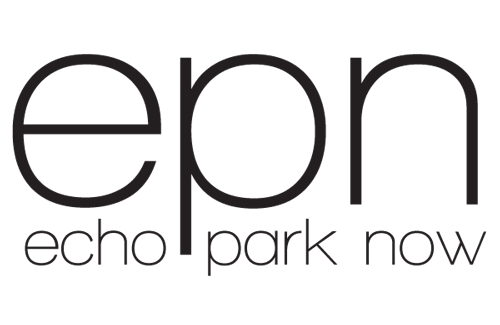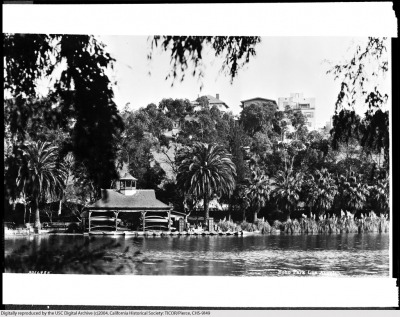Flashback Fridays – Early 20th Century Echo Park Lake
We recently found some photos in the University of Southern California’s Digital Library of Echo Park in the very beginning of the 20th century.
We’ve posted some of the pictures here for your enjoyment. The photo above was accompanied by a lovely account of the beginnings Echo Park Lake written by Jose Rivera.
Initially, the area we now know as the park was a natural arroyo that filled with water from a spring-fed stream that originated at Baxter Street and flowed down what is now Echo Park Avenue. In 1868 the Los Angeles Canal and Reservoir Co. dammed the arroyo to make a reservoir that aided in powering a woolen mill at what is now 6th and Figueroa (then known as Pearl St.) and was to eventually serve local residents, walnut orchards and vineyards to the south along Alvarado. The immigrants that worked these orchards and vineyards settled here and began to build small homes along Sunset Boulevard, between Echo Park Avenue and Lemoyne Street.
In 1875, the woolen mill closed and the reservoir land (then known as the Montana Tract) was sold off. Eventually, Thomas J. Kelley and Dr. W. Lemoyne Wills purchased the land for a business venture. In 1888, Mr. Kelley and Dr. Wills donated the land to the city for the expressed purpose of creating a public park for the enjoyment of the people of Los Angeles.
The first Superintendent of Parks for the city was an English immigrant named Joseph Tomlinson who was assigned the task of creating the park. One day, while overseeing the work, Mr. Tomlinson thought he heard his workers talking during a break, but he knew they were across the park from him. The park had an echo! He knew what the name of the park would be! The park was dedicated and opened to the public in 1895. The famous bed of lotuses that grow in the lake at the northwest end of the park, the largest stand of lotuses outside Asia, is a mystery yet to be solved. One legend says that evangelical Chinese missionaries planted them for use as food, but no one knows the real story. They appeared some time in 1923 or 1924.
Click below to view more photos.




https://myadsite.in/user/profile/18943
http://www.buyselltrademyanmar.com/user/profile/98761
http://onuraydogdu.com/Soru-Cevap/index.php?qa=user&qa_1=galbraithgalbraith1
http://www.associazionehombre.it/index.php?option=com_k2&view=itemlist&task=user&id=1345709
http://ojs.ufgd.edu.br/index.php/edufgd/user/viewPublicProfile/911861
Good article. I definitely love this site. Stick with it!
http://www.southjerseywriters.com/members/emborglanier2/activity/149247/
Everything is very open with a clear clarification of the issues. It was definitely informative. Your site is extremely helpful. Many thanks for sharing!
http://finehomesphotography.com/?page_id=156
https://galbraithlamont1.bravejournal.net/post/2020/03/20/Tips-Mencari-Website-Judi-Online-Legal
http://www.tuscancountrystore.com/index.php?option=com_k2&view=itemlist&task=user&id=1614235
http://www.agriturismo-spigno.it/index.php?option=com_k2&view=itemlist&task=user&id=619566
https://zenwriting.net/emborglamont9/tips-memilih-permainan-judi-bola
https://www.flowersonline.it/index.php?option=com_k2&view=itemlist&task=user&id=671894
http://sualaptop365.edu.vn/members/kristiansenlamont8.353682/
http://www.usaclassifieds.org/user/profile/88690
http://www.ubiqueict.com/index.php?option=com_k2&view=itemlist&task=user&id=1338131
https://occasa.be/author/saundersmcpherson1/
http://www.harvestemple.org/index.php?option=com_k2&view=itemlist&task=user&id=104659
Hello there! I could have sworn I’ve been to this web site before but after going through many of the articles I realized it’s new to me. Anyhow, I’m definitely delighted I found it and I’ll be book-marking it and checking back often!
https://getsatisfaction.com/people/mcphersongalbraith6
https://www.instructables.com/member/kristiansenlamont5/
You have made some good points there. I checked on the net to learn more about the issue and found most people will go along with your views on this website.
http://sha.kaichou.biz/oze/p7070037-2
http://thaifixing.com/author/kristiansenmcpherson2/
http://www.agriverdesa.it/index.php?option=com_k2&view=itemlist&task=user&id=1134745
https://stackoverflow.com/users/story/13094208
https://www.vive4x4.com/index.php?option=com_k2&view=itemlist&task=user&id=34443
http://www.rclegends.co.uk/discussion/167155/website-judi-terbaik-dan-recommended?new=1
Very good post. I am dealing with a few of these issues as well..
http://www.associazioneridere.it/index.php?option=com_k2&view=itemlist&task=user&id=1609370
http://blog.winkylux.com/winky-lux-roosevelt-field-store-event/winkylux-7/
http://www.feedbooks.com/user/5950090/profile
Good information. Lucky me I recently found your site by accident (stumbleupon). I have book-marked it for later!
http://onuraydogdu.com/Soru-Cevap/index.php?qa=user&qa_1=galbraithgalbraith1
http://avenirassurance.com/index.php?option=com_k2&view=itemlist&task=user&id=87168
http://startstudio.lt/index.php?option=com_k2&view=itemlist&task=user&id=147313
https://galter.northwestern.edu/exit?url=http://107.152.47.106/
https://www.transtats.bts.gov/exit.asp?url=http://107.152.47.106/
I blog frequently and I genuinely thank you for your content. Your article has really peaked my interest. I will take a note of your blog and keep checking for new information about once a week. I opted in for your RSS feed as well.
http://1ukclassifieds.com/index.php/author/kristiansenemborg8/
http://uae.nolcart.com/index.php?page=user&action=pub_profile&id=220306
I blog frequently and I really thank you for your content. Your article has really peaked my interest. I’m going to book mark your website and keep checking for new details about once a week. I subscribed to your Feed too.
http://www.crownsignuae.com/uncategorized-2/bewertung-von-medizinische-hausarbeit/
https://www.flowersonline.it/index.php?option=com_k2&view=itemlist&task=user&id=671894
http://3dmaxku.com/home.php?mod=space&uid=196680
http://1ukclassifieds.com/index.php/author/kristiansenemborg8/
http://gwsinstitute.com/members/laniermcpherson1/activity/139234/
https://www.gaiaonline.com/profiles/devinegalbraith9/44547636/
http://customerpolicedepartment.com/members/devinesaunders8/activity/250132/